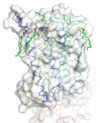Sandbox Reserved 1161
From Proteopedia
(Difference between revisions)
| (22 intermediate revisions not shown.) | |||
| Line 1: | Line 1: | ||
| - | + | == Human metabotropic glutamate receptor 5 transmembrane domain == | |
| - | == | + | <StructureSection load='4oo9' size='350' frame='true' side='right' caption='Human metabotropic glutamate receptor 5 transmembrane domain' <'scene='(Ionic_lock)'> |
| - | <StructureSection load=' | + | |
| - | + | ||
| - | + | ||
| - | == | + | <StructureSection load='4oo9' size='300' frame='true' side='right' caption='Human metabotropic glutamate receptor 5 transmembrane domain' scene='72/721531/Protien_clean_sce/1'> |
| + | Receiving and responding to extracellular messages is critical to the proper function of the nervous system. Glutamate is the major excitory neurotransmitter of the CNS, and metabotropic glutamate receptor 5 will play a major role in glutamate signaling. Metabotropic glutamate receptor 5 transmembrane domain is a homodimeric [[GPCR]] that resides in the cellular membrane <ref name="Dore" />. This domain is a member of the Class C GPCR family and can further be categorized into the Group I subgroup. The transmembrane domain will signal through a Gq/11 pathway. mGlu5 will bind glutamate to the extracellular Venus flytrap domain and the signal will be transduced across the membrane to a heterotrimeric G protein, which will ultimately lead to calcium release and activation of PKC. This will elicit a excitory post-synaptic repose and modulate long term potentiation. Human metabotropic glutamate receptor 5 is found throughout the central nervous system. Areas containing high concentrations of this protein are often involved involved in emotions and higher cognition<ref name="Niswender" />. The localization of mGlu5 in the CNS and the presence of multiple domains makes mGlu5 a possible target for treating schizophrenia,[http://www.fragilex.org/fragile-x/fragile-x-syndrome/ Fragile X], depression, anxiety,and Alzheimer's disease<ref name="Wu" />. | ||
| - | = | + | <ref name="Dore">PMID: 25042998</ref> |
| - | == | + | == Structure == |
| + | [[Image:STR.png|100 px|left|thumb|Cross section view of mavoglurant in the binding pocket]] | ||
| + | === Extracellular Domain === | ||
| - | == | + | This is the <scene name='72/721532/Ecl_trail_1/7'>Extracellular Loops</scene> shows the extracellular loops (ECL) 1, 2, and 3 highlighted in purple. Additionally in the ECL domain, a <scene name='72/721532/Ecl_trail_1/6'>Disulfide Bond</scene> is attached to Helix 3 and the Amino Acid chain between Helix 5 and the N terminus. The disulfide bond is highlighted in yellow, and it is conserved in all classes of glutamate receptor 5 transmembrane domains. |
| + | |||
| + | === Binding Pocket === | ||
| + | [[Image: Organic with clipped surface.png|100 px|left|thumb|Cross section view of mavoglurant in the binding pocket]] | ||
| + | |||
| + | In the 7 transmembrane domain (TMD), <scene name='72/721532/Mavoglurant_in_pocket/4'>Mavoglurant</scene> is in the 7TM domain pocket. Also, the lysozyme is attached to the intercellular region of the TMD. | ||
| + | |||
| + | The variation can be seen in positioning of alpha helices. Class C has seemingly less space for [https://fragilex.org/2014/research/news-reports-and-commentaries/novartis-announces-results-of-mavoglurant-mglur5-afq056-clinical-trials-and-the-conclusion-of-the-long-term-extension-study/ mavoglurant] to enter compared to Class A and F (Wu). The binding of mavoglurant is seen to be varied in different locations due to helix position (Dore). | ||
| + | |||
| + | |||
| + | == Function and Pathway == | ||
| + | |||
| + | It all begins with glutamate binding to the venus fly trap domain. The signal transduction goes across the cystine-rich domain to the TMD. Next the dimerization of the TMD occurs. This activates the Gq/11 pathway, which activates phspholipase Cβ. The active phospholipase Cβ performs hydrolysis on phosphotinositides and generates [https://pubchem.ncbi.nlm.nih.gov/compound/439456#section=Top/ inositol 1,4,5-trisphosphate] and [https://en.wikipedia.org/wiki/Diglyceride/ diacyl-glycerol]. This results in calcium mobilization and activation of protein kinase C. (Niswender, Colleen M..(2010). "Metabotropic Glutamate Receptors: Physiology, Pharmacology, and Disease." Annu. Rev. Pharmacol. Toxicol. Annual Review of Pharmacology and Toxicology 50.1: 295-322.) | ||
| + | |||
| + | == Disease == | ||
| - | + | === Parkinson's === | |
| - | </ | + | Receiving and responding to extracellular messages is critical to the proper function of the nervous system. Glutamate is the major excitory neurotransmitter of the CNS, and metabotropic glutamate receptor 5 will play a major role in glutamate signaling. Metabotropic glutamate receptor 5 transmembrane domain is a homodimeric GPCR that resides in the cellular membrane <ref name="Dore" />. This domain is a member of the Class C GPCR family and can further be categorized into the Group I subgroup. The transmembrane domain will signal through a Gq/11 pathway. mGlu5 will bind glutamate to the extracellular Venus flytrap domain and the signal will be transduced across the membrane to a heterotrimeric G protein, which will ultimately lead to calcium release and activation of PKC. This will elicit a excitory post-synaptic repose and modulate long term potentiation. Human metabotropic glutamate receptor 5 is found throughout the central nervous system. Areas containing high concentrations of this protein are often involved involved in emotions and higher cognition<ref name="Wu" />. The localization of mGlu5 in the CNS and the presence of multiple domains makes mGlu5 a possible target for treating schizophrenia, Fragile X, depression, anxiety,and Alzheimer's disease<ref name="Wu" />. |
| - | = | + | |
| - | < | + | |
Current revision
Human metabotropic glutamate receptor 5 transmembrane domain
| |||||||||||


